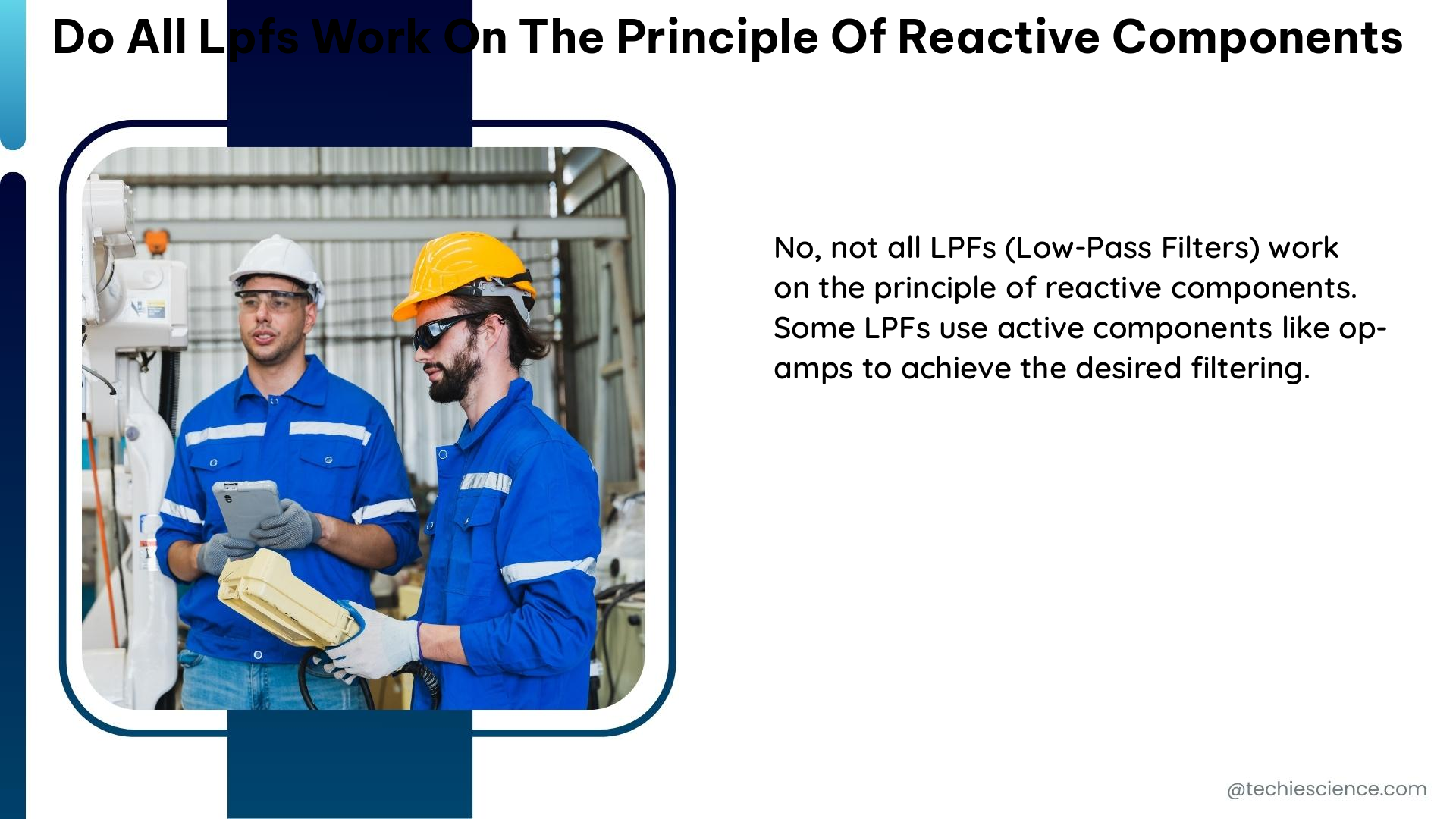Low Pass Filters (LPFs) are a fundamental concept in electronics and control systems, and they operate on the principle of reactive components. LPFs are designed to allow low-frequency signals to pass through while blocking high-frequency signals. This is achieved by using reactive components such as capacitors and inductors, which have a phase shift between the voltage and current.
Understanding the Principle of Reactive Components in LPFs
Reactive components, such as capacitors and inductors, are the key to the operation of LPFs. These components exhibit a phase shift between the voltage and current, which is the basis for their filtering capabilities.
Capacitors
Capacitors are reactive components that store energy in the form of an electric field. When a voltage is applied across a capacitor, it takes time for the capacitor to charge up, and this time delay results in a phase shift between the voltage and current. The phase shift is frequency-dependent, with higher frequencies experiencing a greater phase shift.
Inductors
Inductors are reactive components that store energy in the form of a magnetic field. When a current flows through an inductor, it creates a magnetic field, and this magnetic field, in turn, induces a voltage that opposes the change in current. This phenomenon, known as self-inductance, also results in a phase shift between the voltage and current, which is frequency-dependent.
LPF Circuit Topology
In a typical LPF circuit, a capacitor and an inductor are connected in series or parallel, forming a reactive network. The combination of these reactive components creates a frequency-dependent phase shift, which is the basis for the filtering action of the LPF.
Applications of LPFs in Control Systems

LPFs are widely used in control systems, where they play a crucial role in filtering signals and estimating parameters.
PowerFlex 755T Flux Vector Tuning
In the context of the PowerFlex 755T Flux Vector Tuning, LPFs are used to filter the velocity feedback signal, which is used to control the motor torque. The LPF bandwidth is a critical parameter that determines the cutoff frequency of the filter. A lower bandwidth results in a smoother velocity estimate but introduces a phase lag, while a higher bandwidth results in a more responsive velocity estimate but introduces more noise.
Load Observer
The Load Observer is another application of LPFs in control systems. It is used to estimate the load torque of the motor by filtering the velocity feedback signal. The Load Observer bandwidth is a tuning parameter that determines the tradeoff between accuracy and responsiveness. A lower bandwidth results in a more accurate load torque estimate but introduces a phase lag, while a higher bandwidth results in a more responsive load torque estimate but introduces more noise.
LPFs in Allostatic Load Regulation
In the context of allostatic load, LPFs are used to filter the hormonal response to stress. The Reactive Scope model proposes that the endocrine system integrates hormonal signals over time, and recurrent LPFs may not have a measurable effect on allostatic load or circulating glucocorticoid levels. However, such events may be integrated into an animal’s perception of risk relative to the PRP, and may induce changes in feedback or other mechanisms that mediate the hormonal response to future energetic challenges.
Tuning Parameters of LPFs
The performance of LPFs is heavily dependent on their tuning parameters, such as the bandwidth. The bandwidth of an LPF determines the cutoff frequency, which separates the low-frequency signals that are allowed to pass through from the high-frequency signals that are blocked.
Bandwidth
The bandwidth of an LPF is a critical parameter that determines the tradeoff between accuracy and responsiveness. A lower bandwidth results in a smoother output signal but introduces a phase lag, while a higher bandwidth results in a more responsive output but introduces more noise.
Cutoff Frequency
The cutoff frequency of an LPF is the frequency at which the signal attenuation is 3 dB (approximately 70.7% of the input signal amplitude). Signals with frequencies below the cutoff frequency are allowed to pass through, while signals with frequencies above the cutoff frequency are attenuated.
Phase Lag
The phase lag introduced by an LPF is another important parameter that affects the performance of the system. The phase lag is frequency-dependent and is caused by the reactive components in the LPF circuit. A lower bandwidth LPF will have a greater phase lag, which can impact the stability and responsiveness of the control system.
Conclusion
In summary, LPFs are widely used in electronics and control systems, and they operate on the principle of reactive components. LPFs are used to filter signals and estimate parameters in control systems, and they are also used to filter hormonal responses to stress in the context of allostatic load. The tuning parameters of LPFs, such as the bandwidth and cutoff frequency, determine the tradeoff between accuracy and responsiveness, and they play a crucial role in the performance of the overall system.
References:
– Rockwell Automation. PowerFlex 755T Flux Vector Tuning – Literature Library. https://literature.rockwellautomation.com/idc/groups/literature/documents/at/750-at006_-en-p.pdf
– Romero, L. M., & Wingfield, J. C. (2016). Allostasis, allostatic load, and stress. Hormones and behavior, 80, 128-135.
– ResearchGate. Functional connectivity. Coherograms between the LPFs of both areas (Wavelet method; see MATERIALS AND METHODS ). https://www.researchgate.net/figure/Functional-connectivity-Coherograms-between-the-LPFs-of-both-areas-Wavelet-method_fig3_49840341

The lambdageeks.com Core SME Team is a group of experienced subject matter experts from diverse scientific and technical fields including Physics, Chemistry, Technology,Electronics & Electrical Engineering, Automotive, Mechanical Engineering. Our team collaborates to create high-quality, well-researched articles on a wide range of science and technology topics for the lambdageeks.com website.
All Our Senior SME are having more than 7 Years of experience in the respective fields . They are either Working Industry Professionals or assocaited With different Universities. Refer Our Authors Page to get to know About our Core SMEs.